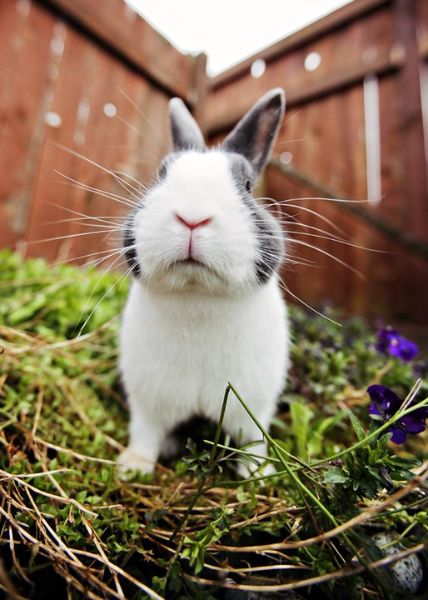Size: Small/Mini
Weight: 4-5.5 lb
Lifespan: 5-8 years
Body Shape: Compact
Best Suited For: Indoor rabbit, Families with young children, First-time rabbit owners, Couples, Seniors
Temperament: Calm, easygoing, energetic, friendly
Comparable Breeds: Havana Rabbit, American Rabbit
Dutch Rabbit Breed History/Origin
The Dutch rabbit is one of the oldest domestic rabbit breeds. It is a descendant of the Petite Brabançon from the Brabant region in Flanders which was bred in large numbers for the meat industry in the late 19th century. The Dutch rabbit is said to have originated sometime around 1850 in Holland, where it is called the Hollander Rabbit. In 1864, it found its way to England where it grew in popularity and has since then been exported to many places around the world.
Appearance
The Dutch is a small to medium sized rabbit, weighing from 1.5kg (3½ lbs) up to about 3kg (6½ lbs), with a breed standard ideal weight of around 2-2.5kg (4-4½ lbs).
Dutch rabbits have a fairly substantial build with a compact, well-rounded body and short, sturdy legs. The head is broad with full cheeks and short, upright ears.
The Dutch rabbit has white markings with a white blaze, white front and white hind legs. A well-marked rabbit is coloured from about the middle of the back to the tail with a straight dividing line, the feet and hind legs are white. The coloured areas of the head incorporate the eyes, cheeks and ears, with an inverted vee-shaped white blaze including the nose.
The Dutch rabbit has short hair and a smooth, glossy coat.
Coat
A Dutch rabbit’s flyback fur is short, glossy and easy to maintain. Like most rabbit breeds, the Dutch rabbit will also go through a seasonal molt (much like a dog when it sheds in the spring). During that time, you will have to groom them a little more often than usual. When they go through molts, you can expect to have your clothes full of their fur when you pick them up and give them some loving, which is why daily brushing during molts is a must. Otherwise, one brushing a week should be sufficient.
Colour
Black, Blue, Chocolate, Yellow, Steel Grey, Brown Grey, Pale Grey, Tortoiseshell.
Temperament
The Dutch rabbit is deservedly one of the most popular pet breeds with its calm, easy-going nature, robust build and manageable size. They have a very gentle disposition and are usually excellent with children, most will happily submit to lots of cuddles. Dutch rabbits are friendly and intelligent and will thrive on attention.
Care
Dutch rabbits are one of the oldest domestic breeds around, so you can be sure that they love to be outside their enclosure whenever possible. They will happily run and jump high into the air when they are out of their hut, especially if they are outside with some soft grass beneath their fuzzy little feet.
Like most rabbits, they will live a long, healthy life so long as they are given plenty of outdoor time and fed a diet of 70 percent hay and the rest being a mix of pellets, fruits and vegetables. However, some fruits and vegetables can pose a danger to their health. Unless you’ve researched the fruit/vegetable and are sure it is safe to feed it to them, the rule of thumb is simply not to feed them if you are unsure. Some food that can be dangerous to your rabbit include seeds from fruits such as apples and pears – they contain tiny particles of cyanide and despite being harmless to humans, they can hurt your rabbit. Bark and cherry tree twigs should be avoided, as well rhubarb and mushrooms.
Their enclosure could be indoors or out, weather and temperature-permitting. Rabbits do not do well in extreme heat and most do not do well in the cold, so always be aware of outdoor conditions before letting your rabbit spend time outside. Their enclosure needs to be clean and dung-free. If there is hay bedding, always be sure to clean it at least once every other day.
There is an age-old question when it comes to the domesticated rabbited: wire enclosure vs. bedding. Rabbits prefer bedding because it is easier on their feet and more comfortable while humans prefer to have wire-bottomed enclosures because it is easier to clean, however it is harder on the rabbit’s feet. With a wire-bottomed enclosure, their excrement simply falls through the wire and onto a removable bottom that owners can easily change while with bedding, you’ll have to go into the enclosure and clean it out, which is more time-consuming. In the end, the decision is that of the owner’s but if you want a happier rabbit, make or purchase an enclosure that has a hay bottom. It may be slightly more time-consuming to clean out their waste, but the result will be a rabbit that is comfortable with their enclosure and is less strenuous on their poor legs. These should be cleaned out thoroughly once a week, while droppings should be removed daily.



















i have a beautiful dutchie girl and she's almost 11 so sweet and cuddly. loved me since the beginining when we met.
ReplyDeleteOoow...thats nice,Dutches are truly amazing.keep loving :)
DeleteWe love your site. Rabbits are very versatile and often do well as indoor house pets. The Dutch rabbit have average life span of five to eight years and this life span can increase up to ten to fifteen years but it appears in very rare cases and not all rabbits reach to this age.Thank you for all the good information.
ReplyDeleteWelcome, and thank you too for appreciating
Delete